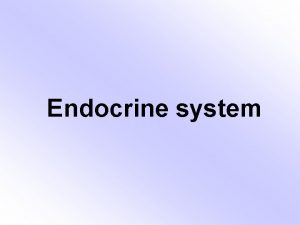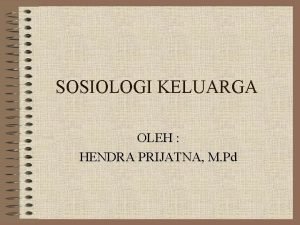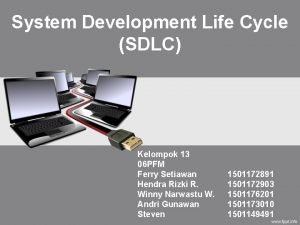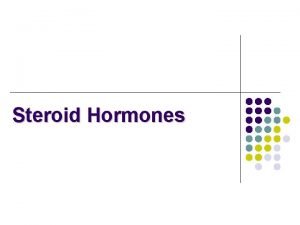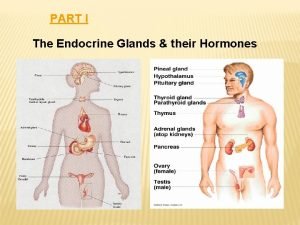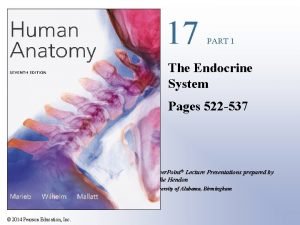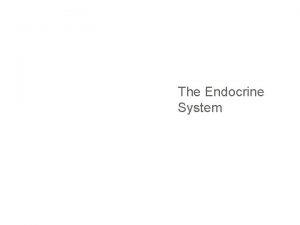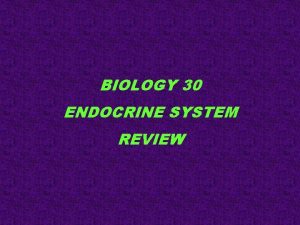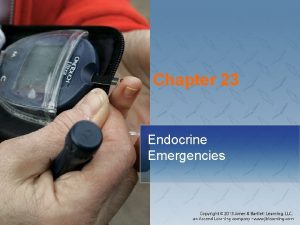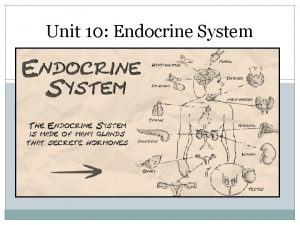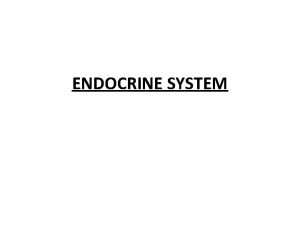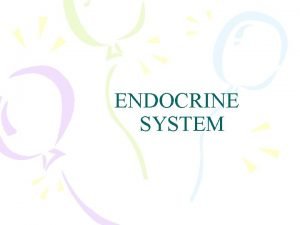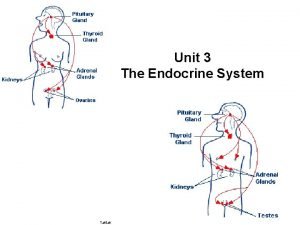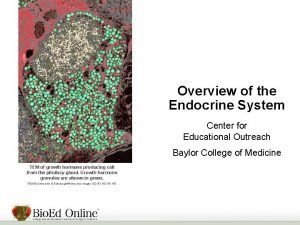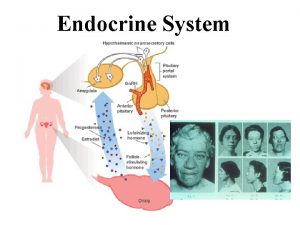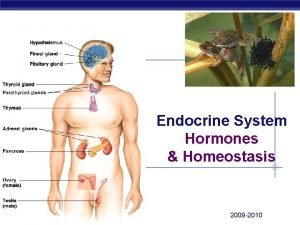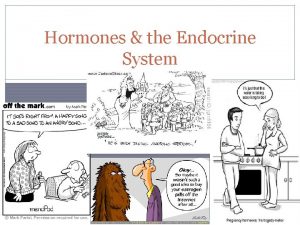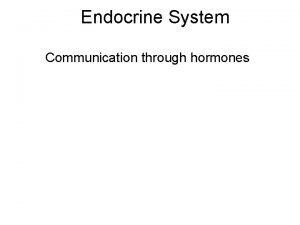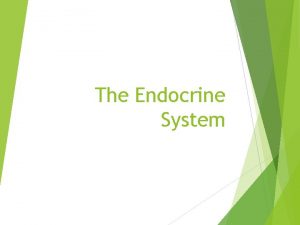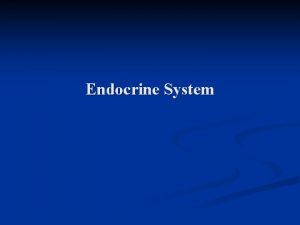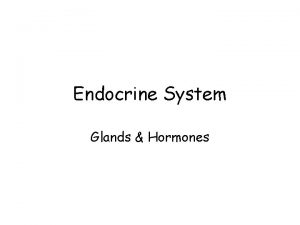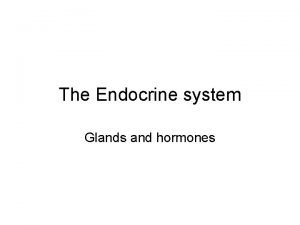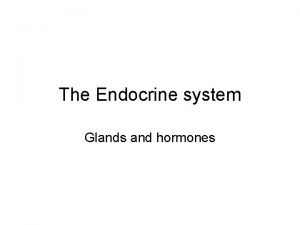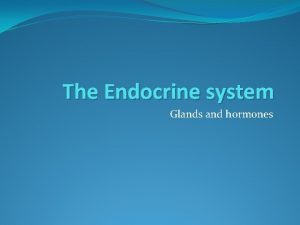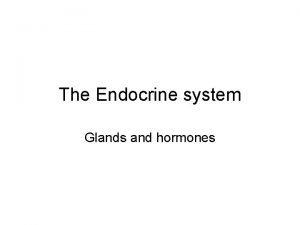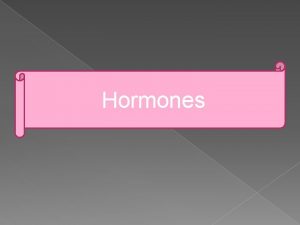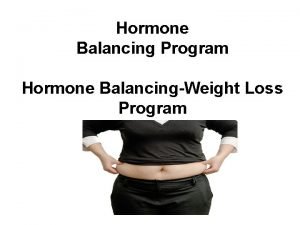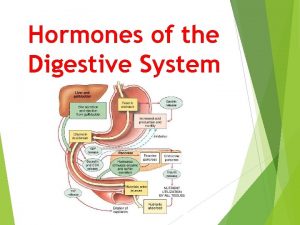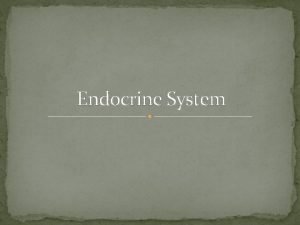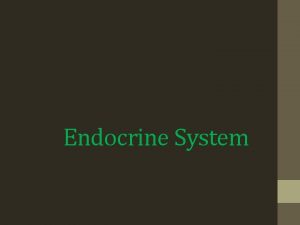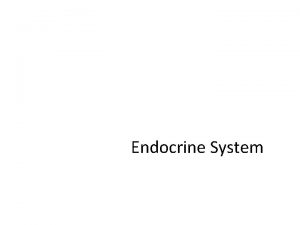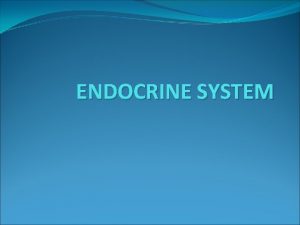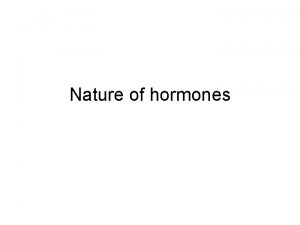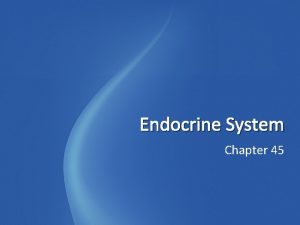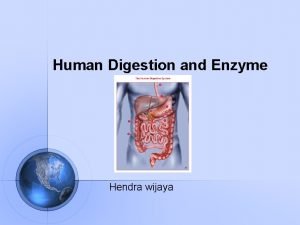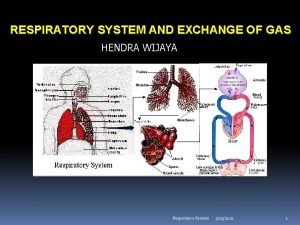Endocrine hormone System Hendra Wijaya Hormones are chemical

















































- Slides: 49

Endocrine (hormone) System Hendra Wijaya

Hormones are chemical messengers secreted by certain tissues into the blood or institial fluid, serving to regulate the activity of other tissues.

Chemical Classification of Hormones • Amine hormones are derived from tyrosine or tryptophan – Include NE, Epi, thyroxine, melatonin • Polypeptide/protein hormones are chains of amino acids – Include ADH, GH, insulin, oxytocin, glucagon, ACTH, PTH • Glycoproteins – Long polypeptide bound to a carbohydrate group – Include LH, FSH, TSH • Steroids are lipids derived from cholesterol – Include testosterone, estrogen, progesterone & cortisol 11 -7

Chemical Classificaton of Hormones • Steroid Hormones: – Lipid soluble – Diffuse through cell membranes – Endocrine organs • • Adrenal cortex Ovaries Testes placenta

Chemical Classification of Hormones • Nonsteroid Hormones: – Not lipid soluble – Received by receptors external to the cell membrane – Endocrine organs • • • Thyroid gland Parathyroid gland Adrenal medulla Pituitary gland pancreas

Regulatory Systems • • Target cells~ body cells that respond to hormones Endocrine system/glands~ hormone secreting system/glands (ductless); exocrine glands secrete chemicals (sweat, mucus, enzymes) through ducts Neurosecretory cells~ actual cells that secrete hormones Feedback mechanisms ~ negative and positive

Endocrine System

Major Endocrine Glands 1. Pineal Gland 2. Hypothalamus 3. Pituitary Gland 1. Anterior 2. Posterior 4. Thyroid Gland 5. Parathyroid Glands 6. Adrenal Glands 6. Cortex 7. Medulla 7. Thymus Gland 8. Pancreas 9. Gonads 6. Ovaries 7. Testes

There is a hierarchical chain of command in hormonal signaling. Coordination center of the endocrine system. Via direct neuronal connection

Hypothalamus-pituitary axis

Feedback control

Feedback control of thyroid function

Mode of Action: Chemical Signaling • 1 - Plasma membrane reception • signal-transduction pathways (neurotransmitters, growth factors, most hormones) • 2 - Cell nucleus reception • steroid hormones, thyroid hormones, some local regulators

Hypothalamus • Part of brain – Regulates ANS, emotions, feeding/satiety, thirst, body temperature, etc. – Hormones related to these functions • “Releasing hormones” • Axonal transport to posterior lobe

Hypotalamus • Hypothalamus and pituitary gland secrete hormones and regulate other endocrine organs. They are the main regulatory organs of the endocrine system.

Hypothalamus • Located below the thalamus and above the pituitary gland (=epiphysis) • Regulates the pituitary gland secretions through two different mechanisms

Hypothalamus - neurohypophysis • 1 - Neurons, receiving information from receptors, fire APs which travel down to the post pituitary gland stimulate the release of stored neurohormones – Oxytocin (OT) and anti-diuretic hormone (ADH)

Pituitary Gland • • • Releasing and inhibiting hormones Anterior pituitary: Growth (GH)~bones √gigantism/dwarfism √acromegaly Prolactin (PRL)~mammary glands; milk production Follicle-stimulating (FSH) & Luteinizing (LH)~ovaries/testes Thyroid-stimulating (TSH)~ thyroid Adrenocorticotropic (ACTH)~ adrenal cortex Melanocyte-stimulating (MSH) Endorphins~natural ‘opiates’; brain pain receptors

Hormones of the Anterior Pituitary

Hypothalamus & Pituitary Gland

Posterior Region of the Pituitary Gland • The posterior pituitary: • Oxytocin~ uterine and mammary gland cell contraction • Antidiuretic (ADH)~ retention of water by kidneys


The Pineal, Thyroid, & Parathyroid • Melatonin~ pineal gland; biological rhythms • Thyroid hormones: Calcitonin~ lowers blood calcium Thyroxine~ metabolic processes • Parathyroid (PTH)~ raises blood calcium

The thyroid gland - Chp 21 p 623 -625 • Located in the neck, just below the larynx • Secrete 2 types of hormone: - thyroid hormones stimulate cell metabolism, triiodothyronine (T 3) and thyroxine (T 4) – iodine is needed to synthesize these hormones - calcitonin decrease blood calcium Figure 6. 8 a

Thyroid hormones • T 3 and T 4 secreted by the follicular cells • Stored as colloid • Parafollicular cells (C cells) secrete calcitonin (Chp 19)

Thyroid Hormones T 3 and T 4 • Target organs: all cells • Role: Increase cell metabolism, oxygen consumption • Permissive role for some other hormones (growth hormone)

Thyroid hormone regulation Figure 6. 7

Goiter • Both hypo and hyperthyroidism can have goiter as a symptom • Goiter is a swelling of the neck due to hypertrophy of the thyroid gland • How can one explain that?

Goiter in hypothyroidism • • • Most often due to a lack of dietary iodine The thyroid hormone is unable to synthesize a functional thyroid hormone (T 3 and T 4) The person express symptoms of hypothyroidism The nonfunctional T 3/T 4 cannot promote a negative feedback on TRH and TSH the hypotalamus and pituitary gland increase their secretions the thyroid gland is stimulated to secrete more T 3 and T 4 … In children, the lack of functional T 3/T 4 result in cretinism, a form a mental retardation

Goiter in hyperthyroidism • The cells secreting TRH or TSH on the hypothalamus and pituitary gland (respectively) have become abnormal and no longer are sensitive to the negative feedback they continue to secrete TRH or TSH continuous stimulation of the thyroid gland with excess thyroid hormones being formed • symptoms of hyperthyroidism

Parathyroid glands • Four nodules located in the back of the thyroid gland • Secreted parathyroid hormone or parathormone or PTH • Action of PTH opposes action of calcitonin • Both hormones play a role in calcium metabolism

Roles of calcium • Most calcium ions are stored in the bones • Calcium is an important cofactor for enzymatic activity, plays a role in blood coagulation and action potentials. • Calcitonin and PTH participate in calcium regulation • Vitamin D helps PTH activity

Calcium regulation: • Calcitonin promotes blood calcium decrease, by: - 1. calcium deposition on bone - 2. calcium dumping by the kidney • PTH promotes blood calcium increase by: - 1. bone resorption - 2. calcium reabsorption by kidney - 3. increase calcium absorption by intestine

Calcium Metabolism: Figure 23 -20: Calcium balance in the body

Figure 19. 20

The Pancreas • Islets of Langerhans • Alpha cells: • glucagon~ raises blood glucose levels • Beta cells: • insulin~ lowers blood glucose levels • Type I diabetes mellitus (insulin-dependent; autoimmune disorder) • Type II diabetes mellitus (non-insulin-dependent; reduced responsiveness in insulin targets)

The pancreas • Located in the left upper abdominal cavity • Exocrine and endocrine glands • The endocrine function is due to the cells of the islets of the Langerhans -- α cells glucagon -- β insulin -- δ somatostatin

Glucose regulation • Glucose level controlled by insulin and glucagon • Insulin promotes a decrease in blood glucose • Glucagon promotes an increase in blood glucose

Glucose regulation

Fate of glucose Figure 3. 21

Diabetes mellitus • Type I: autoimmune disease beta cells of the islets of Langerhans are destroyed by antibodies • Type II: The cells become insulin-resistant glucose does not enter the cells as readily • http: //faculty. weber. edu/nokazaki/Human_Physiol ogy/Class%20 notes/diabetes. htm

The Adrenal Glands • Adrenal medulla (catecholamines): • epinephrine & norepinephrine~ increase basal metabolic rate (blood glucose and pressure) • Adrenal cortex (corticosteroids): • glucocorticoids (cortisol)~ raise blood glucose • mineralocorticoids (aldosterone)~ reabsorption of Na+ and K+


The Gonads • Steroid hormones: precursor is cholesterol – Androgens (testosterone) • sperm formation • male secondary sex characteristics; gonadotropin – Estrogens (estradiol) • uterine lining growth • female secondary sex characteristics • gonadotropin – Progestins (progesterone) • uterine lining growth

The Gonads • Steroid hormones: precursor is cholesterol • androgens (testosterone)~ sperm formation; male secondary sex characteristics; gonadotropin • estrogens (estradiol)~uterine lining growth; female secondary sex characteristics; gonadotropin • progestins (progesterone)~uterine lining growth

Revision: Major endocrine conditions Endocrine Gland Hormones Endocrine Disorders Anterior Pituitary Growth Hormone Gigantism, acromegaly Dwarfism Thyroid Thyroxine (T 4) Triodothronine (T 3) Thyrotoxicosis Goitre Exopthalmos Hypothroidism Cretinism Myxoedema Goitre Parathyroid Parathormone Osteoporosis Kidney stones Tetany Adrenal Cortex Glucacorticoids Cushings syndrome Addisons disease Adrenal Medulla Epinephrine Norepinephrine Increased metabolism Hypertension Pancreatic Islets Insulin Hyper Hypo Diabetes mellitus

Pituitary Dwarfism

Hyper secretion of Growth hormone: Gigantism

 Chapter 45 hormones and the endocrine system
Chapter 45 hormones and the endocrine system Chapter 45 hormones and the endocrine system
Chapter 45 hormones and the endocrine system Mikael ferm
Mikael ferm Nervosa
Nervosa Hypothalamus gland
Hypothalamus gland Ppt tugas kuliah
Ppt tugas kuliah Arti nusyuz
Arti nusyuz Abdullah suriosubroto
Abdullah suriosubroto Hendra setiawan ferry yoegianto
Hendra setiawan ferry yoegianto Niko wijaya
Niko wijaya Gerak bunga wijaya kusuma
Gerak bunga wijaya kusuma Cakra wijaya kusuma
Cakra wijaya kusuma Vonny wijaya
Vonny wijaya Lily wijaya
Lily wijaya Yuliagnis transver wijaya
Yuliagnis transver wijaya Dr juliana wijaya
Dr juliana wijaya Hormones chemical classification
Hormones chemical classification Endocrine system and reproductive system
Endocrine system and reproductive system Endocrine system vs nervous system
Endocrine system vs nervous system Lymphatic system vs endocrine system
Lymphatic system vs endocrine system Mechanism of hormone action
Mechanism of hormone action Endocrine system and nervous system
Endocrine system and nervous system Reproductive physiology
Reproductive physiology Chapter 16 matching questions 1-5
Chapter 16 matching questions 1-5 Adenohypophysis
Adenohypophysis Differences between nervous system and endocrine
Differences between nervous system and endocrine Comparison of endocrine and nervous system
Comparison of endocrine and nervous system Gonads glands
Gonads glands Endocrine system fact
Endocrine system fact Diaphragm of rat
Diaphragm of rat Metabolic action of growth hormone
Metabolic action of growth hormone Are endocrine glands ductless
Are endocrine glands ductless 7:13 endocrine system
7:13 endocrine system Mammillary body
Mammillary body Stimulus humoral
Stimulus humoral Hypothal
Hypothal Biology 30 endocrine system
Biology 30 endocrine system Chromaffin cells
Chromaffin cells Chapter 23 the endocrine system
Chapter 23 the endocrine system Endocrine system analogy
Endocrine system analogy Introduction of endocrine system
Introduction of endocrine system Classification of hormones
Classification of hormones T3.taktak
T3.taktak Endocrine system
Endocrine system Classification of hormone
Classification of hormone Pancreas in endocrine system
Pancreas in endocrine system Endocrine glands
Endocrine glands Endocrine system
Endocrine system Chapter 16 lesson 3 the female reproductive system
Chapter 16 lesson 3 the female reproductive system Endocrine system regents questions
Endocrine system regents questions



